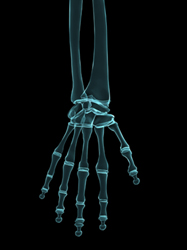Fits like a glove
The research is part of a larger project works on the basis of furthering scientific understanding of the functionality of the human anatomy and physiological and pathological conditions associated with it. Such research undertaken by the MULTISENSE project, it is hoped, will speed up the progress being made in the medical field and industrial areas such as biomedical engineering. In particular the focus has been to find a way to represent the functional anatomy in a 3D way, which up until now has proved very difficult. Creating such 3D representations will enable the visual and virtual manipulation of these anatomical objects and so enable innovative techniques to be tested. Scientists at the University of Salford in the UK have turned their attention to the creation of a hand exoskeleton structure. It can be used both to simulate the hand and to support it as it strengthens the overall movements, grasping and flexing. The device operates on the index, middle and ring fingers and the thumb, providing a feedback force from the dorsal side of the hand. The feedback forces are generated by direct current motors mounted in a low profile power pack and are transmitted to the fingers by low friction pull-cables. The device allows for the measurement of the finger flexion, which is possible due to the combination of flexible resistive sensors and electromagnetic sensors embedded in the glove. The device is made out of soft lycra glove and a metallic structure; this enables ease of movement and allows for the measurements to be taken. The incorporated glove, unlike other systems, is part of the exoskeleton structure and thus it is faster to put on and take off. It is designed to fit a range of hand sizes and for this purpose it incorporates adjustment levers that allow fast and easy adjustment of the metallic structure for the three fingers.







